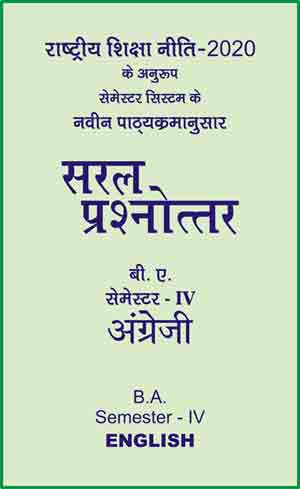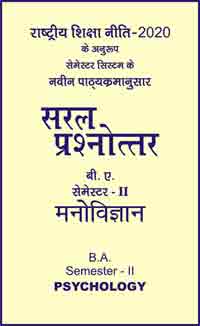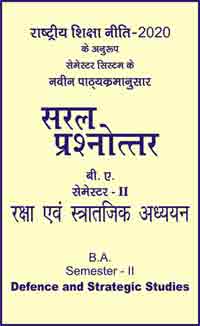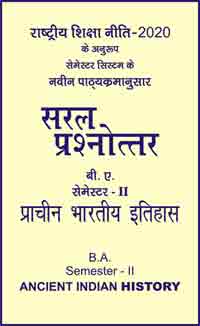|
बी ए - एम ए >> बीए सेमेस्टर-4 अंग्रेजी बीए सेमेस्टर-4 अंग्रेजीसरल प्रश्नोत्तर समूह
|
5 पाठक हैं |
|||||||
बीए सेमेस्टर-4 अंग्रेजी - सरल प्रश्नोत्तर
Important Facts to Remember
During the 1920-30s Jayshankar Prasad's poetry was believed by many to be an example of what poetry ought to be. He was a poet of desires and his peculiar genius lay in his ability to fashion language to suit his poetry. The result was that readers were captivated by his craftsmanship and the sentiments he expressed in his poems. The experience of his poems when they were first read became the experience of a lifetime, since those first moments could never be forgotten. Prasad created them as though they were honey-combs, and knew that whatever else poems may have been they were a skillfully constructed art of words. No one in Hindi treated this art more seriously and few sacrificed more to it.
His life (1889-1937) was an endless struggle against financial troubles, ill health, and the death of a young son and two wives in the prime of their youth. Wringing out every drop of poetry from his life, this struggle ultimately led him to a cruel death at forty-eight, at the height of his creative power, immediately after he published his greatest work, Kamayani. With the pain of the knowledge that love is the most compelling reason for living, he must have suffered long months of melancholy and solitude.
The verses in Ansu 'tears' (1933), abstracted from personal life, speak of that knowledge and that suffering. They are the result of a mixture of biography and allegory (if one wishes to descend deeper in search for philosophical value). The expression of feelings experienced during many poignant moments fill the entire book, unfolding themselves in the framework of a pure poetic reality. They are melodious, touching, and sensitive, and honor the memory of that great love and its beauty.
The recreation of that love and beauty and the poignant moments associated with them is the primary purpose of these poems, and the poet interprets them in an exacting sense. In these poems this re-creation is much more fully perceived and evaluated than in actual life, where love and beauty have to survive the confusion of a person's actual history and in which unrelated sentiments occur as scaffolding. Since their publication in 1933, these verses have given emotional pleasure to their readers. Many readers of these poems are enchanted by them before they stop to ponder over their meaning, which may appear to be a poor thing in comparison with the enchantment. The poems succeed through the magnificence of their poetry, and no analysis can take its place. The reason for this is the character of the emotions inspired by these verses. The re-creation is done by means of metaphors from nature, until the entire uni verse is gathered up into that great love and its loss for which all the 190 verses are weeping.
The dewdrops; stars, moonlight, buds, waves, the sweet-smelling bowers of flowering creepers, and the like are poetic elements and have double characters. Each item at once is an element in a virtual event and evokes an emotional response. The poignant pathos of these poems is true to the heart and to life. Some of these verses are undeniably mystic, particularly those in which the object of the poet's devotion is addressed in a languge of love so deeply respectful that it can hardly be intended for a human being. Perhaps they are addressed to the Eternal Feminine which is an aspect of God, the Ardhanarisvara. This may explain the occasional use of the masculine gender for the beloved.
There is nothing in these verses that does not have an emotional value, and the appreciation of this emotion would not be helped much by additional knowledge, by the meanings and motives which only scholarship can supply. They would add very little to the verse's poetic significance and its essential appreciation. They may in fact clutter the po- etic image of life with extraneous items extraneous be- cause they do not spring from the emotions inspired by the verses. These verses explain themselves without the need of comment.
The sentiments of these poems can be reproduced more or less in other languages, but their metrical effects and the magic of the Hindi words must make any translator despair. Furthermore, the enchantment that a poem produces and the understanding of it are the result of a communion between the words and the readers who comprehend them in terms of their own experience. To no two readers is a poem's meaning identical. Then there are other dissimilarities. The cultural and historical memories of an American are quite different from those of a Hindi-speaking reader from India or elsewhere. To translate verses calls for a high degree of sensibility, technique, and knowledge. Professor White would not claim that his translations of the verses of Ansù are perfect, since it is sheer folly to imagine that translations are or can hope to be perfect. However, the fact remains that poems have values that transcend differences of language, culture, time, and place, and in this translation, like in Professor White's earlier translations of Sri Harivamsha's bhakti poems in Braj Bhasha, the renowned scholar of Indian poetic thoughts has greatly succeeded.
The work is a lyric, composed in the form of independent couplets, conventionally arranged as four-line stanzas. The principal theme of these stanzas is the separation of a lover from his beloved although some of the verses portray the union of the lovers. Ansu, "tears," are emotionally wrenched from the pining heart of a lover who seems to have been separated from his beloved, or even rejected; yet, he some- times recollects with pleasure the days he used to spend in the company of his beloved. Some critics have described the poet's state as one of communion of the soul with God on the transcendental plane, or the reverse, separation from God.
"Prasad is an emotional poet and an expert artist in Hindi. If someone wants to see these qualities in one composition, then he can be directed to study Ansu." (Vinay Mohan Sharma, Kavi Prasad: Ansu Tatha Anya Kritihän, [Varanasi: Varanasi Vishvavidyalaya Prakashan, 1966], p. 89.) Sharma says that Ansu is attractive for two main reasons: 1. The memory of love has been truly depicted; 2. The method of expression is exquisite. "Ansü is the representative composition of the Chayavada age." In Kamayani, Prasad's final, great epic, poetry has been subordinated to the philosophy. In Ansu philosophy supports the poetry. Of course the poet wants to relate himself to the agony of the world, but the beauty of the work lies in the union of poetry and art.
The unintroduced point-of-view is that the narrator thinks of the glorious, romantic past, which has caused him so much suffering. The beautiful, intoxicating image of the beloved rises before his eyes and settles there. He thinks deeply of her arrival, of their first meeting and introduction. Perhaps she did not belong to this earth, rather she was the personification of heavenly splendor that came down to earth to meet him. He lost his very being in his love for her; and when she left, his heart at times, when not shedding tears, seemed to burn with her memories.
The hero of Ansu forgets his own grief at times or at least tries to transmute it as he thinks about the troubles of the world. He prays that nature may minimize the agony of the world and he advises his own grief not to be too busy with itself but to see itself in relation to the general grief. Our tears should be shed for the troubles of all the grief-stricken individuals in the world.
Another idea that critics find in Ansu is that of the "annihilation of the individual in society." At first we are attracted towards the physical beauty of the beloved and consider her almost to be God. We forget everything in her worship. But then that physical beauty and pleasure are snatched from us and we are rolling about in our agony and we weep and we swim alternately in hope and despair. As the reality of our loss increases, and we lose hope of ever attaining the beloved, we begin to feel that the final aim of life is the welfare of the world.
The structure of Ansu is harmonious. It can be compared to a string of pearls, which shines as a whole, and yet each pearl shines separately as well. V.M. Sharma has this opinion: he says that in the case of T.S. Elliot, "His poetry can be called a music of ideas. They are there to be re- sponded to, not to be pondered or worked out." The same thing can be said about Prasad's Ansu.
After reading Ansu through one can well understand that the underlying meaning of the poem and its particular references are subject to various interpretations. It is not known for certain who the beloved was, who led the poet into such an intense relationship. Most of the references suggest a youthful woman, possibly a courtesan of the musician-dancer type that still form a professional class in parts of India. Because Hindi verbs indicate gender as well as person and number, there is an ambiguity at times, concerning gender.
A very prominent theme in Ansu has to do with "the pangs of separation" or viraha. As far as Indian love poetry is concerned, it is nothing new; in fact it is the principal pre-occupation of all the love poets from Kalidasa onward. Viraha is also a leading element in the theological exposition of the cult of Radha. The description and categorization of the states or bhavas of emotion, expressed by lovers, is adapted to religious poetry in part on the basis of the classical literary theory of Sanskrit." The move theologically is to understand the relationship of the soul or self to God as that of a lover pining for union or communion with the Be- loved, the Divine Being. It is likely that Prasad's intense descriptions of separation from and loss of the human be- loved are, at least in part, meant to be metaphorically related to the separation that all human beings experience - poets and saints more intensely perhaps than others in the very nature of human existence, separated from an eternal Companion beyond the transitory level of the natural world, however filled with beauty that may be.
Composed in 1924-25, the first edition of Ansu was published in 1925 and contained 126 verses. The second edition, published in 1933, had 190 verses. The Hindi text quoted is that published by Indian Publishing House: Delhi, 1975 from the second edition.
|
|||||














